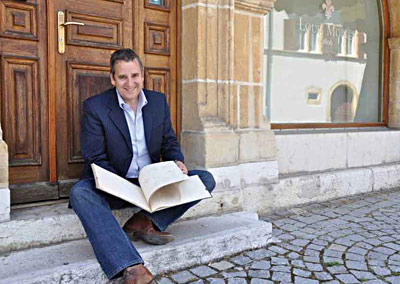Without a doubt, however, French watchmaker Louis Moinet is one of the most famous names in watchmaking, right up there with Abraham Louis Breguet and Daniel Jean-Richard.

“Louis Moinet, even as a small boy, was interested in art and watches,” says Jean-Marie Schaller, president and CEO of the newly launched brand Louis Moinet. “He took apart watches and reassembled them at an early age. When he was 20, he went to Italy to study the arts. When he came back to France, he was made professor of Fine Arts at the Louvre at 27 years old. When he came back to Paris, it was art and watches for him. Five years later, the balance shifted, and he was making only watches. He was making the movements, and he was interested in the art of it as well. He made clocks for Napoleon.”
“For Louis Moinet, watches were a combination of mechanical and artistic work,” Schaller continues. “Soon, he was recognized by his peers as a gifted gentleman. At 32, he was nominated president of the chronometry society of Paris, a gathering of watchmakers who wanted to share experiences and develop watchmaking. He also collaborated with a famous bronze maker, Thomire, and together they produced clocks that they sold to Napoleon and King George IV of England and two American presidents, Jefferson and Monroe. There is a Louis Moinet clock, featuring the Goddess Minerva, in the White House, purchased by President Monroe. It says Louis Moinet on the movement. The Jefferson clock is at Monticello.”
In 1848, Moinet wrote and published a definitive book on watchmaking called The Watchmaking Treatise (Traité d'horlogerie in French), a two-volume work in which he shared his ideas and concepts with the world. It became an important reference for watchmakers and is still in libraries throughout the watch industry. Filled with Moinet's own illustrations and drawings, it took him 20 years to write the text, which is widely considered the best-written and most comprehensive book on watchmaking. “Louis Moinet was a good man; he encouraged young watchmakers; he was helpful in mediating disputes about watchmaking; they went to him for arbitrage,” Schaller says. “He was held in high esteem by the other watchmakers.”
Schaller fell in love with Louis Moinet's unique universe and represents now the younger generation in charge of maintaining the company's traditions. When he started his research in 1999, he knew of Moinet's illustrious history, but there was nothing else to be purchased—Moinet had died in 1853, and there was no stock and certainly no watches. Then Schaller discovered original editions of Moinet's treatise, including illustrations and sketches in Moinet's own hand, and these have since become the very backbone of the brand. When reading the Treatise, he also found out astonishing inventions : Louis Moinet invented a sensational instrument: a counter in the shape of a watch displaying 60ths of a second, and which he called a “compte-tierce” or 60th of a second counter, whose goal was to enhance Louis Moinet's astronomical observations. The obvious advantage was a degree of superior to any other time measurement, and it places Louis Moinet as one of the "fathers" of chronometry. Another invention was a jewelled escapement that oscillated at 216,000 vibrations per hour without any trace of wear nor increased friction during prolonged use.
It's not the Louis Moinet mission to just copy the vintage watches and try to sell them. “There is a strong history, but we don't want to simply repeat the past,” Schaller says. “We update the designs and make them contemporary. We use the Côtes du Jura, which we have created, because we are not in Geneva, so we didn't want to do Geneva striping. We have registered the Côtes du Jura and it is a strong element of our brand DNA”
The Louis Moinet customer is not someone buying his first watch. Usually, the way it goes is that people who are interested in mechanical watches buy an Omega or a Rolex; then they buy something more complicated; then they want something more exclusive, like Louis Moinet. Collectors, watch lovers, people who want uniqueness, these are the Louis Moinet customers. “We are trying to build on the heritage of Louis Moinet,” says Schaller. “We are applying for patents; we have products that are completely new. In a sense, what we do is pay homage to Louis Moinet and pursue his work in a contemporary way.”
While many companies are trying to bring many parts of the production process in-house, Louis Moinet is doing things the old fashioned way. Design, logistics, marketing and distribution are based in the company's headquarters in Saint-Blaise, Switzerland in a beautiful old building that used to be a bank, but for the production of the watches, the brand works with a network of small suppliers. “Our suppliers are our partners, people who share the same spirit,” Schaller says. “We have already changed a lot of suppliers because the relationship was not there. Being a small company, sometimes it works best if we work with other small companies. If we go to a big dial maker, we don't get the attention that we need.”
Moinet's suppliers are some of the best small companies in the business, and they work for some of the biggest companies in the industry; yet they are happy and willing to work with Louis Moinet. Part of it is Schaller, who has been in the watch industry for a long time and has a reputation as a straight shooter, but another large part is the interest these suppliers have in what Louis Moinet is trying to do. It's doubtful these companies would be working with Louis Moinet if it were just another “me too” watch, but because it is considered something special, they are eager to be on board.
Schaller does all of the exterior design of the watches himself, but lets the professionals do the rest. “I am not good at routine, so I like to invent new things and see the interaction with the market,” he says. “I am enjoying the work. My favorite watch is always the next one. To develop these projects sometimes takes two years, so by the time something is out, I am already working on the next watches."
Keith W. Strandberg, for International Wristwatch







